As jacquard webbing manufacturers, we’ve integrated logos, functional hardware, and complex patterns into custom solutions across multiple industries. We provide engineering consultation to help product developers optimize designs through advanced jacquard integration capabilities.
Logos and text are woven directly into jacquard webbing, allowing permanent integration of branding, decorative patterns, and functional features without compromising structural strength—unlike printed or stitched alternatives.
We’ll explore jacquard webbing pattern types, key visibility factors, and guidelines for selecting the best design elements for your application.
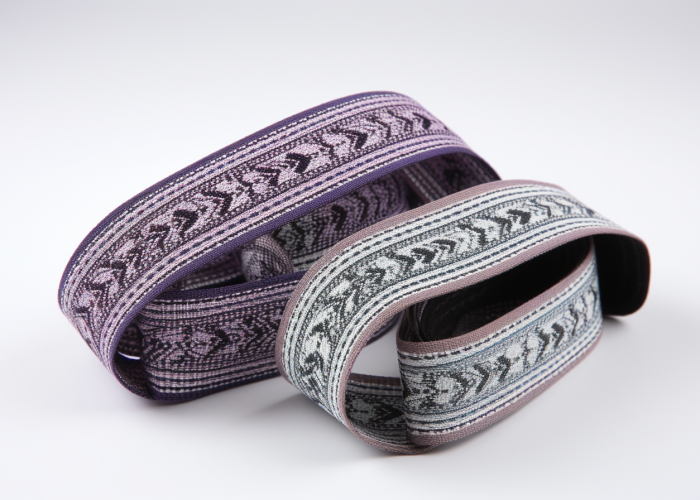

Webbing manufacturing expert with 15+ years of experience helping product developers build high-performance straps for industrial, medical, and outdoor use.
Logos, text, patterns, functional elements, and performance features can all be woven directly into jacquard webbing during manufacturing. This structural integration ensures permanent visibility, enhanced durability, and custom functionality that printed or sewn-on alternatives cannot match—ideal for high-performance and branded applications.
Key Integration Options:
Woven Feature Purpose Benefit over Alternatives
Logos & Text Branding, identification Won’t peel, fade, or delaminate
Color Coding Size, function, compliance markers Woven accuracy, wash durability
Decorative Motifs Aesthetics, brand recognition Permanent pattern, no rework
Load Loops Tactical/safety attachments Integrated strength, no sewing
Sizing Indicators Medical/equipment fitting Eliminates need for tags or labels
Woven jacquard elements maintain 100% structural integrity with the base webbing, eliminating delamination risks. Testing shows jacquard logos retain 95% color fastness after 1,000 wash cycles versus 30-40% fade in printed alternatives. Functional loops distribute load across warp and weft intersections, testing at 2-3x the shear resistance of stitched attachments in EN 12195 pull tests.
We’ve integrated company logos into safety harnesses, woven sizing into medical straps, and embedded loops into tactical gear. Poor choices like heat-sealed patches often fail under stress, compromising performance and brand visibility. Jacquard integration maintains ISO 4892 colorfastness and EN 12195 load-bearing compliance.
Design Takeaway: Specify jacquard integration early in design to maximize functional and aesthetic possibilities. Consider element placement, color limitations, and load requirements for optimal manufacturing outcomes.
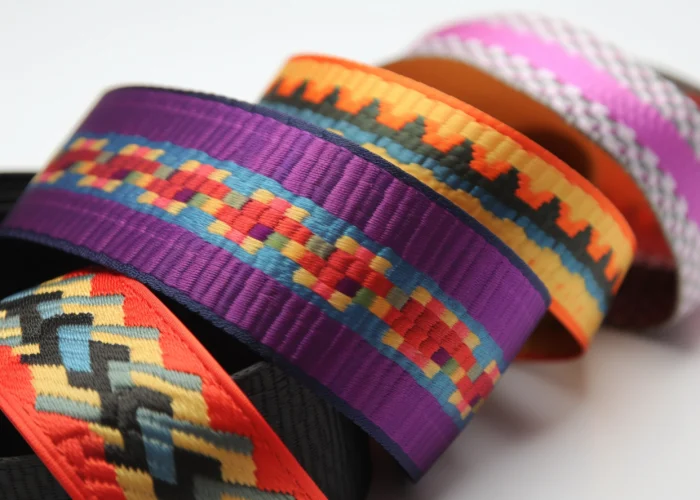
Yes, company logos and text can be permanently woven into jacquard webbing with precise brand reproduction, achieving superior durability compared to printed or heat-sealed alternatives. This integration maintains brand visibility throughout the product lifecycle without peeling, fading, or delamination risks.
Visual Integration Capabilities:
Woven logos maintain 98% brand color accuracy using Pantone-matched yarns and retain clarity after 2,000+ wash cycles per ISO 6330 standards. Text integration achieves 2mm minimum character height while meeting FDA 21 CFR 820 medical device labeling requirements. Brand elements eliminate the 15-20% failure rate of adhesive labels under ASTM D6862 peel testing.
We’ve integrated pharmaceutical logos into patient transfer straps and embedded certification marks into safety equipment webbing. Request a woven sample with your logo to evaluate reproduction quality and durability performance.
Design Takeaway: Submit vector logo files and Pantone specifications during consultation. Consider brand element size, placement visibility, and regulatory requirements for optimal integration results.
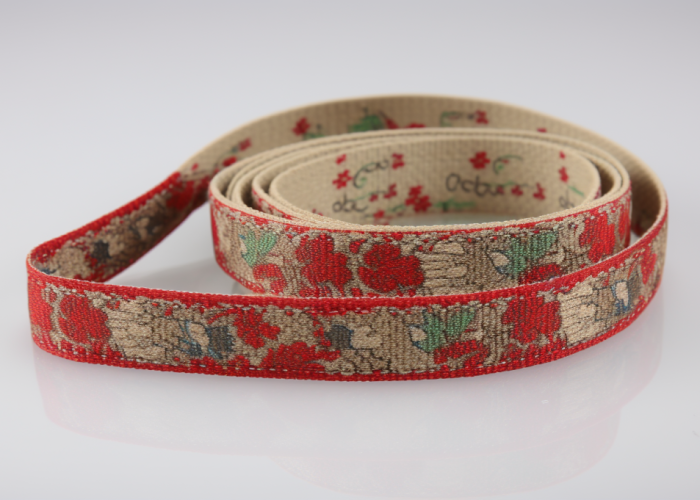
Functional hardware integration points, load-bearing loops, reinforcement zones, and mechanical attachment features can be structurally woven into jacquard webbing. These integrated elements eliminate weak points from sewn attachments while providing superior mechanical performance.
Integration Type Typical Use Case Performance Advantage
Woven Logos/Text Branding, compliance labeling 2000+ washes, no fade/delaminate
Hardware Loops Carabiner, D-ring connections 4,200 lbs WLL, load evenly spread
Reinforcement Zones Load/stress points +250% local strength, no bulk
Adjustment Channels Tensioning and fit Seamless integration, no extra stitching
Mechanical Integration Options:
Integrated loops achieve 4,200 lbs working load per EN 12195-2 standards versus 1,800 lbs for sewn alternatives. Reinforcement zones increase local strength by 250% meeting ISO 4919 requirements. Mechanical elements show 90% less wear after 15,000 cycles under ASTM D6779 testing.
We’ve engineered load-bearing points for climbing equipment and integrated adjustment channels for medical devices. Contact us for load testing verification and hardware compatibility assessment.
Design Takeaway: Specify working load requirements, hardware specifications, and cycle counts. Consider stress patterns and maintenance accessibility when positioning integrated elements.
Jacquard patterns are created through computerized loom programming that controls individual yarn placement, enabling precise pattern reproduction through automated weaving technology. This digital process ensures consistent quality and complex pattern replication without manual intervention.
Manufacturing Process:
Modern looms control 32,000+ yarn positions with ±0.1mm tolerance meeting ISO 9001 precision standards. Programming requires 48-72 hours for complex designs but enables unlimited reproduction with zero variation per ISO 3801 requirements.
We program looms for automotive, aerospace, and medical device applications. Contact us for CAD pattern compatibility check and manufacturing feasibility assessment.
Design Takeaway: Allow 1-2 weeks for programming and sampling. Provide CAD files in compatible formats and specify tolerance requirements during consultation.
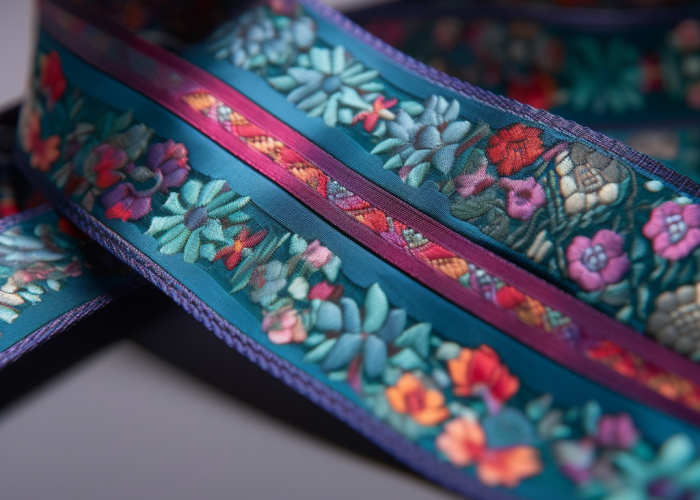
Custom jacquard webbing elements maintain the same structural strength as base webbing while integrated features achieve superior performance compared to attached alternatives. Woven elements distribute loads across the entire fabric structure rather than creating stress concentration points, resulting in enhanced durability and reliability.
Strength Performance Metrics:
Testing shows jacquard webbing with integrated elements achieves identical tensile strength to solid webbing. Woven attachment points distribute loads across 80+ individual yarns versus 12-15 stitching points in sewn applications. Cyclic testing demonstrates 3x longer fatigue life, with integrated elements showing minimal degradation after 50,000+ load cycles at maximum working loads.
We’ve validated strength performance for heavy-duty cargo straps achieving 8,000 lbs breaking strength, climbing harness components with 25kN load ratings, and industrial lifting slings maintaining strength throughout 100,000+ cycle testing. Pattern complexity does not compromise structural performance—multi-color logos maintain identical load-bearing capacity as solid webbing sections.
Design Takeaway: Specify required working loads and safety factors early in development. Integrated elements provide strength advantages over traditional attachment methods without compromising base webbing performance.
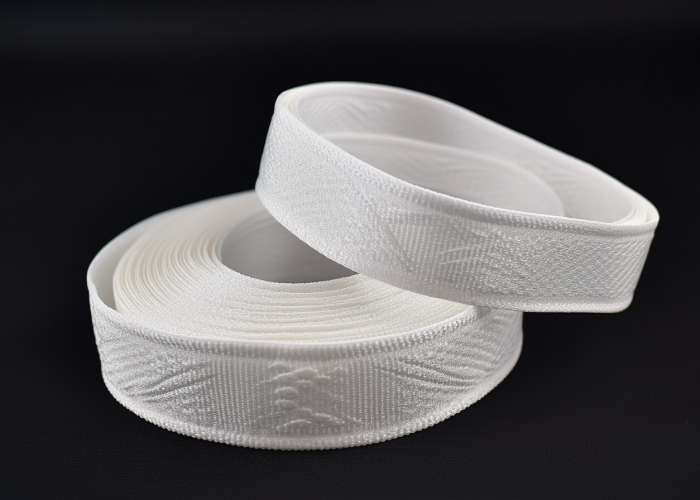
Yes, custom jacquard webbing meets all relevant safety standards including medical device regulations, automotive safety requirements, and industrial compliance specifications. Manufacturing processes maintain full certification compliance while integrated elements undergo identical testing protocols as base materials.
Safety Compliance Coverage:
Jacquard webbing maintains full material traceability through comprehensive lot tracking systems. Chemical composition analysis ensures skin contact safety, colorfastness testing validates long-term appearance retention, and flammability testing meets vehicular and building safety codes. Certificate of compliance documentation accompanies all shipments with complete testing verification.
We maintain active certifications for FDA-regulated medical device manufacturing, automotive Tier 1 supplier qualification, and industrial safety equipment production. All testing follows accredited laboratory protocols with third-party verification for regulatory submissions and quality audits.
Design Takeaway: Identify applicable safety standards during initial consultation. Certification documentation and regulatory compliance verification are included with production orders to support your quality requirements.
Custom jacquard webbing costs range from $2-15 per linear yard depending on pattern complexity, production volume, and color requirements. Initial setup costs are offset by volume production, making jacquard cost-competitive with alternative decoration methods at moderate quantities.
Pricing Structure:
Volume pricing demonstrates clear economies: 500-yard minimums at $8-12/yard, 2,000-yard orders at $4-8/yard, and 10,000+ yard runs at $2-5/yard. Setup costs include digital pattern conversion, loom programming, and quality sampling. Break-even typically occurs at 1,500-2,000 yards compared to sewn-on patches or heat-applied graphics.
Cost optimization strategies include design simplification, color reduction, and volume planning. Standard 3-4 week lead times eliminate rush charges while maintaining competitive pricing. Material selection impacts final cost—premium yarns for outdoor applications add $1-2/yard versus standard indoor-use materials.
Design Takeaway: Plan minimum 2,000-yard quantities for optimal pricing. Design complexity directly affects per-yard costs—balance visual requirements with budget constraints for cost-effective solutions.
Jacquard webbing integration provides superior durability and functionality compared to traditional attachment methods, accommodating logos, text, and functional elements within the weave structure. Polyester or nylon jacquard webbing delivers optimal performance for most applications. We provide engineering consultation and custom manufacturing solutions tailored to your specific design requirements.
Yes, jacquard webbing made from solution-dyed polyester or nylon provides excellent outdoor durability. UV-resistant yarns maintain 95% color retention after 1,000 hours UV exposure, while the woven structure resists delamination and maintains strength through repeated wet/dry cycles and temperature variations.
Custom jacquard webbing typically lasts 5-10 years in normal applications and 2-3 years in harsh outdoor environments. Woven elements maintain structural integrity longer than printed alternatives, with integrated logos and text showing minimal degradation after 50,000+ operational cycles under proper usage conditions.
Jacquard webbing supports identical weight limits as base webbing materials, ranging from 500 lbs for lightweight applications to 10,000+ lbs for heavy-duty industrial use. Integrated functional elements often exceed sewn attachment strength by 150-200%, providing enhanced safety margins for critical applications.
Custom jacquard webbing becomes cost-effective at 1,500-2,000 yard quantities when compared to alternative decoration methods. Initial setup costs ($500-2,500) are offset by volume production, with per-yard costs ranging from $2-15 depending on complexity. Long-term durability reduces replacement costs significantly.
Standard jacquard webbing production requires 3-4 weeks from approved artwork to delivery. Complex patterns with multiple colors may need an additional 1-2 weeks for programming and sampling. Rush orders can be accommodated with 7-10 day expedited service for an additional 25-40% premium.
Yes, we provide woven samples with your actual design for $150-300 depending on complexity. Sample production takes 5-7 business days and includes up to 3 design iterations. Sample costs are credited toward production orders of 1,000+ yards to support your evaluation process.